IMPROBABLY FRENCH, INCREDIBLY RUSSIAN! WHAT IS IT?
Classical ballet born in France has been well settled down in Russia since the end of the 18th century. However, the French language are being used in the lessons of the ballet schools and during the rehearsals of the Ballet theatres throughout the world up to now. Plié, jeté, pas de chat, fouetté. These terms speak little for the ordinary ear. Yet it`s a word to the wise for the ballet professionals.
 Bolshoy Theatre, the turn of the 19 c. Winter.
Let`s remember the famous lines:
EUGENE ONEGIN, Stanza XX
A throng of nymphs around her now,
Istomena stands; then cautiously,
With one foot lightly on the ground
With the other she turns herself around,
Then a sudden leap, and now she's flying.
(Trans. by Gerard R. Ledger)
Possibly not being aware of it Pushkin exactly described the ballet movements of the port de bras (pohr duh brah) and jeté battu (zjeh-tay' bah-tew' ). The ballet vocabulary (terminology) was formed in France owing to the King of France Louis 14.
He adored the choreography and thoroughly learned the art of ballet. In 1671 Louis XIV made up his mind to establish Académie Royale de Danse (Royal Academy of Dance) and ordered great French choreograher Pierre Beauchamps to codify the ballet movements.
Then the main ballet pas (pah) (`steps`) which have been in use so far were described by him, the very movements that are learned in the ballet schools, trained in the rehearsals of the ballet companies and peformed by dancers on the stage. The five right and five wrong positions of feet in ballet were established in Pierre Beauchamps` time. The right ones en dehors (ahn dah-ohr') were turned-inside-out positions with the toes turned out. They were used in the noble dances, first of all, in the regal menuette. The wrong feet`s positions, with the turned in toes (toes in) served for the dancing of the comic characters.
Bolshoy Theatre, the turn of the 19 c. Winter.
Let`s remember the famous lines:
EUGENE ONEGIN, Stanza XX
A throng of nymphs around her now,
Istomena stands; then cautiously,
With one foot lightly on the ground
With the other she turns herself around,
Then a sudden leap, and now she's flying.
(Trans. by Gerard R. Ledger)
Possibly not being aware of it Pushkin exactly described the ballet movements of the port de bras (pohr duh brah) and jeté battu (zjeh-tay' bah-tew' ). The ballet vocabulary (terminology) was formed in France owing to the King of France Louis 14.
He adored the choreography and thoroughly learned the art of ballet. In 1671 Louis XIV made up his mind to establish Académie Royale de Danse (Royal Academy of Dance) and ordered great French choreograher Pierre Beauchamps to codify the ballet movements.
Then the main ballet pas (pah) (`steps`) which have been in use so far were described by him, the very movements that are learned in the ballet schools, trained in the rehearsals of the ballet companies and peformed by dancers on the stage. The five right and five wrong positions of feet in ballet were established in Pierre Beauchamps` time. The right ones en dehors (ahn dah-ohr') were turned-inside-out positions with the toes turned out. They were used in the noble dances, first of all, in the regal menuette. The wrong feet`s positions, with the turned in toes (toes in) served for the dancing of the comic characters.
 Pierre Beauchamps (boh-ʃɑ̃`)(1631-1705)
The 20c. great Russian choreographer Mikhail Fokin`s character Pulchinello (pulchi-) movements were based on the wrong positions of feet. That became an accent of Pulcinello, the clumsy, intimidated title character of the same name iconic ballet. Igor Stravinsky `Pulcinello` Pierre Beauchamps gave a detailed description of the turned-inside-out positions, as well as positions of arms and legs during squats plié (plee-yay`).
Pierre Beauchamps (boh-ʃɑ̃`)(1631-1705)
The 20c. great Russian choreographer Mikhail Fokin`s character Pulchinello (pulchi-) movements were based on the wrong positions of feet. That became an accent of Pulcinello, the clumsy, intimidated title character of the same name iconic ballet. Igor Stravinsky `Pulcinello` Pierre Beauchamps gave a detailed description of the turned-inside-out positions, as well as positions of arms and legs during squats plié (plee-yay`).
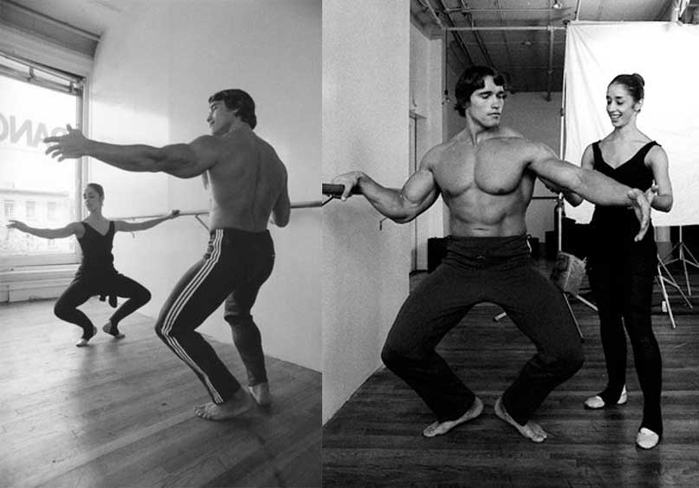 Schwarzenegger`s Plié
Now they open any lesson of the classical ballet, both attended by the first formers and famous ballet stars. Ideal position of feet remains the main feature and advantage of the French ballet school.
The moving of arms from one position to another with the simultaneous bending of trunk and turning of head is known as the port de bras (pohr duh brah`). The ability of moving hands in a nice manner, so called `speaking`, `singing` arms and hands is a trademark of the Russian ballet school. The great Russian ballerina Maya Plisetskaya`s various port de bras bewitched the whole world.
Maya Plisetskaya: `At the very moment when feet are in the strict classical positions your arms and hands are free to express everything. Nationality, temper, epoch. Any possible mood! I`m going to illustrate it for you: that movement of my arms transform the classical ballet in the Russian folk dance, now that my arms and hands moves like that my legs and feet keep dancing the classical dance.
Schwarzenegger`s Plié
Now they open any lesson of the classical ballet, both attended by the first formers and famous ballet stars. Ideal position of feet remains the main feature and advantage of the French ballet school.
The moving of arms from one position to another with the simultaneous bending of trunk and turning of head is known as the port de bras (pohr duh brah`). The ability of moving hands in a nice manner, so called `speaking`, `singing` arms and hands is a trademark of the Russian ballet school. The great Russian ballerina Maya Plisetskaya`s various port de bras bewitched the whole world.
Maya Plisetskaya: `At the very moment when feet are in the strict classical positions your arms and hands are free to express everything. Nationality, temper, epoch. Any possible mood! I`m going to illustrate it for you: that movement of my arms transform the classical ballet in the Russian folk dance, now that my arms and hands moves like that my legs and feet keep dancing the classical dance.
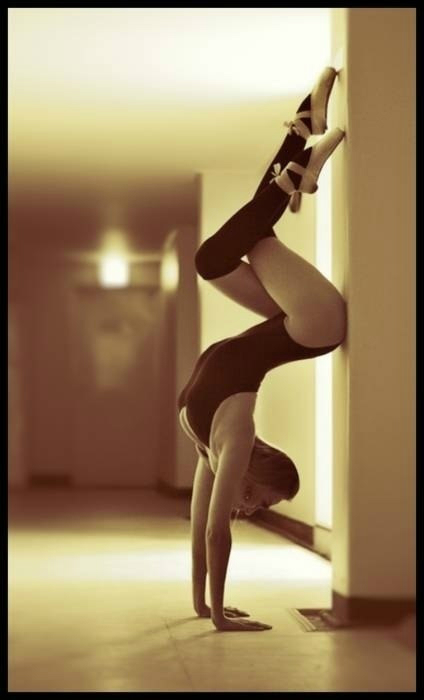 In the `Laurencia` I`ve got the imaginary castanets in my hands, I move my arms and hands like this or like that, but the same movements of them are impossible, for example, in the `Swan Lake`, because it`s Spain! And that position is India. And that one is Persia!
Battement (baht-mahn') is an exercise for legs and feet. There are several dozens of movements of that kind. Every kind of the battement is intended for its own artistic task. High and nice raise (rise, lift) of a leg is a pride of any ballerina. The best exercise for forming such a raise is considered to be the battement tendu (baht-mahn' tahn-du`).
It`s speed and dexterity that are achieved by the battement frappé (baht-mahn' fra-pay`) and petit battement (puh-teet baht-mahn'). When performing that movement, legs `flicker` as in a slow motion. You can hardly count all the `strokes`.
The battement fondue (baht-mahn' fohn-dew') teaches the dancers to move tenderly, smoothly and gracefully.
It`s a `melting` battement, when dancers` legs move backwards and aside, so the leg of a dancer `opens` itself, but the regular exhausting repetition of that movement is not associated with the delicious Swiss dish `Fondue`, the yummy mixture of cheece and chocolate, for the ballet dancers.
The majestic grand battement (grahn baht-mahn') crowns the exercising at a portable barre. The legs of dancers `take off` in all directions beyond their heads! Sometimes that kind of battement is very useful not only for the scene, but also in life.
In the `Laurencia` I`ve got the imaginary castanets in my hands, I move my arms and hands like this or like that, but the same movements of them are impossible, for example, in the `Swan Lake`, because it`s Spain! And that position is India. And that one is Persia!
Battement (baht-mahn') is an exercise for legs and feet. There are several dozens of movements of that kind. Every kind of the battement is intended for its own artistic task. High and nice raise (rise, lift) of a leg is a pride of any ballerina. The best exercise for forming such a raise is considered to be the battement tendu (baht-mahn' tahn-du`).
It`s speed and dexterity that are achieved by the battement frappé (baht-mahn' fra-pay`) and petit battement (puh-teet baht-mahn'). When performing that movement, legs `flicker` as in a slow motion. You can hardly count all the `strokes`.
The battement fondue (baht-mahn' fohn-dew') teaches the dancers to move tenderly, smoothly and gracefully.
It`s a `melting` battement, when dancers` legs move backwards and aside, so the leg of a dancer `opens` itself, but the regular exhausting repetition of that movement is not associated with the delicious Swiss dish `Fondue`, the yummy mixture of cheece and chocolate, for the ballet dancers.
The majestic grand battement (grahn baht-mahn') crowns the exercising at a portable barre. The legs of dancers `take off` in all directions beyond their heads! Sometimes that kind of battement is very useful not only for the scene, but also in life.
|
|
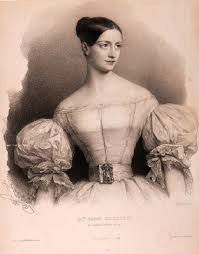 Fanny Essler (1810-1884)
There was a case when great Austrian ballerina of the 19 c. Fanny Essler used that movement to beat off the robbers who offered her a choice between her life and purse. She disarmed them with mighty strokes of her legs as a karate girl! By the way, the same movements have been really and anciently used in the martial arts!
Having performed the exercising at a portable barre (the barres) dancers continue to practise ballet movements in the middle of the dance floor.
The dance can be divided for convenience into a quick (fast) and slow one, like music that can be slow Adagio (ah-dazj'-eh-oh) and quick (fast) Allegro (ah-leh'-groh). These Italian terms were burrowed by the art of ballet from music.
Adagio can be peformed both at a portable barre and in the middle of the hall. Besides, Adagio are danced on the stage, this is a longstanding artistic form of the classical ballet. The Adagio became as well a part of the pas de deux (pah duh duh`) , a twosome dance.
The most adorning movement of an Adagio is the arabesque (ah-rah-besk). That movement was called in that way in honour of the Old Arabian pattern. The romantic ballet regarded the arabesque as a divine movement. It`s in a pose of the arabesque that playful Silphide (silfid`) literally `freezes` on points of her toes.
In the ballet `Giselle` Giselle (zjee-zel`) bends over her love also in a pose of the arabesque. The arabesque prevails in dancing of the Wilis (wee`-lis) in Act 2 of the `Giselle`(the Wilis are not Bruce Willis, but the spirits of young girls who have died before their wedding nights`. - ААП).
Fanny Essler (1810-1884)
There was a case when great Austrian ballerina of the 19 c. Fanny Essler used that movement to beat off the robbers who offered her a choice between her life and purse. She disarmed them with mighty strokes of her legs as a karate girl! By the way, the same movements have been really and anciently used in the martial arts!
Having performed the exercising at a portable barre (the barres) dancers continue to practise ballet movements in the middle of the dance floor.
The dance can be divided for convenience into a quick (fast) and slow one, like music that can be slow Adagio (ah-dazj'-eh-oh) and quick (fast) Allegro (ah-leh'-groh). These Italian terms were burrowed by the art of ballet from music.
Adagio can be peformed both at a portable barre and in the middle of the hall. Besides, Adagio are danced on the stage, this is a longstanding artistic form of the classical ballet. The Adagio became as well a part of the pas de deux (pah duh duh`) , a twosome dance.
The most adorning movement of an Adagio is the arabesque (ah-rah-besk). That movement was called in that way in honour of the Old Arabian pattern. The romantic ballet regarded the arabesque as a divine movement. It`s in a pose of the arabesque that playful Silphide (silfid`) literally `freezes` on points of her toes.
In the ballet `Giselle` Giselle (zjee-zel`) bends over her love also in a pose of the arabesque. The arabesque prevails in dancing of the Wilis (wee`-lis) in Act 2 of the `Giselle`(the Wilis are not Bruce Willis, but the spirits of young girls who have died before their wedding nights`. - ААП).
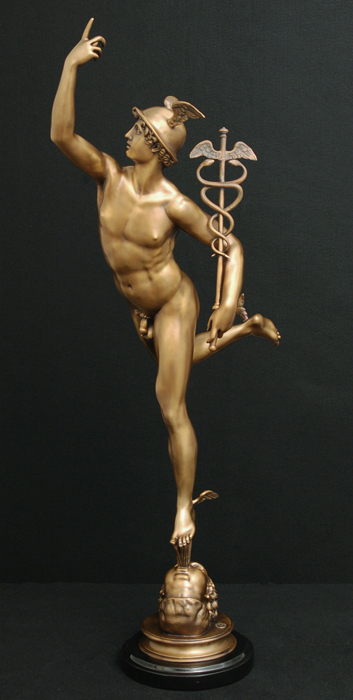 The ballet pose of the attitude (ah-teh-tewd') was invented by Italian choreograher Carlo Blasis (1797-1878). Or, if to be exact, an idea of new movement was prompted by a pose of Mercury statue created by great French and Italian sculptor Giovanni da Bologna (Giambologna, Jean de Boulogne (1529-1608). The climax of the pose of the attitude is the Adagio of Princess Aurora with a ballerina and four partners from the ballet of The Sleeping Beauty. That hymn to the ballet pose of the attitude was `sung` in the language of ballet by a great French and Russian dancer and choreographer Marius Petipa (1818-1910).
Of course, the most spectacular ballet movements are jumps and turns. Both in the floor and in the air. They are thoroughly trained in the class as soon as the `quick` part of the lessons begins. The frequent jumps with the legs moving apart and crossing are named entrechat (ahn-truh-shah'). Once they were performed by Louis XIV himself. They say that once His Majesty not having finished his movement stumbled to the applause of the hypocritical courtiers. And his `newly invented` pas was defined as the entrechat royalle, or the Royal entrechat.
According to the legends the master of a brilliant chain of the hovering entrechats in the 18 c. was a French dancer Jean Balon (Ballon)(bah-lohn`) (1676-1739). Since then his name has been used to define the entrechat as the dancers` ability to challenge the law of gravity. But some say that the ballet term originates from the French word defining a balloon. The soaring and hovering entrechats are presented in the final part of variations of the Blue Bird from the ballet `The Sleeping Beauty`. These variations were initially staged by Marius Petipa exclusively for Italian virtuoso dancer Enrico Cecchetti (1850-1928).
The ballet pose of the attitude (ah-teh-tewd') was invented by Italian choreograher Carlo Blasis (1797-1878). Or, if to be exact, an idea of new movement was prompted by a pose of Mercury statue created by great French and Italian sculptor Giovanni da Bologna (Giambologna, Jean de Boulogne (1529-1608). The climax of the pose of the attitude is the Adagio of Princess Aurora with a ballerina and four partners from the ballet of The Sleeping Beauty. That hymn to the ballet pose of the attitude was `sung` in the language of ballet by a great French and Russian dancer and choreographer Marius Petipa (1818-1910).
Of course, the most spectacular ballet movements are jumps and turns. Both in the floor and in the air. They are thoroughly trained in the class as soon as the `quick` part of the lessons begins. The frequent jumps with the legs moving apart and crossing are named entrechat (ahn-truh-shah'). Once they were performed by Louis XIV himself. They say that once His Majesty not having finished his movement stumbled to the applause of the hypocritical courtiers. And his `newly invented` pas was defined as the entrechat royalle, or the Royal entrechat.
According to the legends the master of a brilliant chain of the hovering entrechats in the 18 c. was a French dancer Jean Balon (Ballon)(bah-lohn`) (1676-1739). Since then his name has been used to define the entrechat as the dancers` ability to challenge the law of gravity. But some say that the ballet term originates from the French word defining a balloon. The soaring and hovering entrechats are presented in the final part of variations of the Blue Bird from the ballet `The Sleeping Beauty`. These variations were initially staged by Marius Petipa exclusively for Italian virtuoso dancer Enrico Cecchetti (1850-1928).
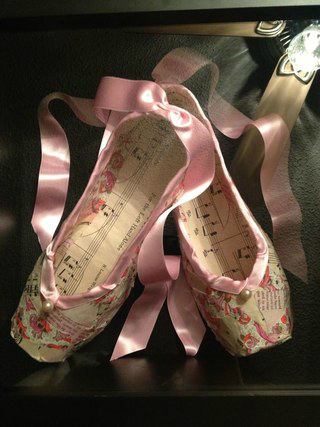 But soon ballerinas started competing with the male ballet dancers too. They proved that their entrechat were no less soaring and hovering ones. The jumps with turns in the air jeté en tournant (zjeh-tay' toor-nahn`) are always met with applause. Performing a chain of those jumps the dancers seem to draw a wide magic circle in the floor.
Some terms came to the ballet art from nature. For instance, it can`t be excluded that the jump cabriole (kah-bree'-ohl) originates from the French word cabri (-bree`), i.e. a kid, goatling (rather than a Chupacabra. - ААП). So the expression `someone jumps as a goat` is not abusive since cabriole is an extraorinarily noble jump.
The smooth, insinuating and tactful jump pas de chats (pah duh shah) was used with good effect by Marius Petipa in the comic scene of the twists and turns of love affair of the black tom cat and white pussy cat in The Sleeping Beauty.
As to the grand pas de chat (grahn pah duh shah`) it`s able to transform the catlike movements (cat`s stepping) into the mistic phantom which is before the wind. The vivid illustration is the ballet `Giselle` when Giselle Wilis rushes diagonally across the scene performing the grand pas de chat. The ballet Don Quixote has got two heroines, they`re Kitri (kee`-tree) and the Queen of the Dryads who perform grand pas de chat, one after another, traversing the arena in the big circles. This splendid contest of two primas permanently draws the stormy applause and has the audience all in the aisles.
The jump pas de poisson (pah duh pwah-sohn) came to the ballet right from the underwater kingdom. The dancer bends backwards, and his legs while he keeps jumping remind of the forked fishtail.
Many ballet movements (steps) and terms earlier belonged to the traditional dances. La Région d'Auvergne of France granted the classical ballet with one of its most essential movements from its dance bourrée. The pas de bourrée (pah duh boo-ray`), the fast and smooth movement of feet on points, the ballerinas perfect from the first class of the ballet schools.
But soon ballerinas started competing with the male ballet dancers too. They proved that their entrechat were no less soaring and hovering ones. The jumps with turns in the air jeté en tournant (zjeh-tay' toor-nahn`) are always met with applause. Performing a chain of those jumps the dancers seem to draw a wide magic circle in the floor.
Some terms came to the ballet art from nature. For instance, it can`t be excluded that the jump cabriole (kah-bree'-ohl) originates from the French word cabri (-bree`), i.e. a kid, goatling (rather than a Chupacabra. - ААП). So the expression `someone jumps as a goat` is not abusive since cabriole is an extraorinarily noble jump.
The smooth, insinuating and tactful jump pas de chats (pah duh shah) was used with good effect by Marius Petipa in the comic scene of the twists and turns of love affair of the black tom cat and white pussy cat in The Sleeping Beauty.
As to the grand pas de chat (grahn pah duh shah`) it`s able to transform the catlike movements (cat`s stepping) into the mistic phantom which is before the wind. The vivid illustration is the ballet `Giselle` when Giselle Wilis rushes diagonally across the scene performing the grand pas de chat. The ballet Don Quixote has got two heroines, they`re Kitri (kee`-tree) and the Queen of the Dryads who perform grand pas de chat, one after another, traversing the arena in the big circles. This splendid contest of two primas permanently draws the stormy applause and has the audience all in the aisles.
The jump pas de poisson (pah duh pwah-sohn) came to the ballet right from the underwater kingdom. The dancer bends backwards, and his legs while he keeps jumping remind of the forked fishtail.
Many ballet movements (steps) and terms earlier belonged to the traditional dances. La Région d'Auvergne of France granted the classical ballet with one of its most essential movements from its dance bourrée. The pas de bourrée (pah duh boo-ray`), the fast and smooth movement of feet on points, the ballerinas perfect from the first class of the ballet schools.
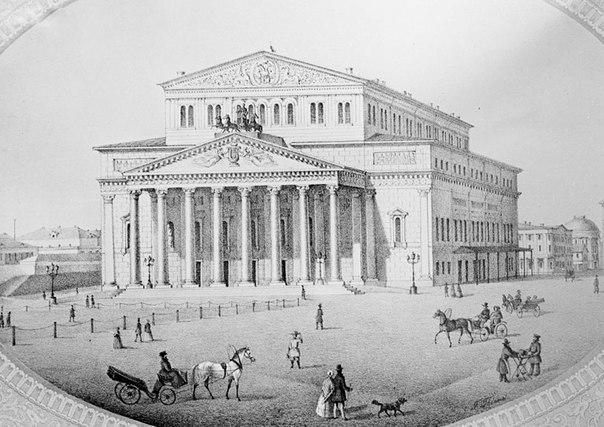 Bolshoy Theatre, the turn of the 19 c. Summer
The synthesis, coinage of the port de bras and pas de bourrée gave birth to the Mikhail Fokin`s immortal miniature of the La Mort du Cygne (The Swan) to Camille Saint-Saëns` (kamij` sɛ̃sɑ̃s`) music.
Traditional dance of the Basques shared its movement, i.e. saut de basque (soh duh bahsk') with the classical ballet. It is performed by ballerinas who make one turn in the air. The spectacular double or even triple saut de basque is a firm guarantee of a success for the male classical ballet dancers.
The Queen of the female ballet turns became the fouetté (fweh-tay'). It`s French for the `lash, whip`. Indeed, one of legs of a whirling ballerina moves like a lash cleaving the air.
The male answer to that achievement of ballerinas became the grand pirouette, or the grand turn. Grand Pirouette demands a high level of the artistic skills.
The important term of the classical ballet is the word aplomb (a.plɔ̃). It has nothing to do with the self-confidence or assurance. It`s but an ability of a ballerina to persistently stand on one leg counterpoising in the most complicated ballet positions. It`s a necessary thing in ballet, that very aplomb.
The magic words of battement, adagio, allegro, etc. sound as an incantation and spell when heard in the ballet classes of the world. They are a basis of the magnificent castle we know as the classical ballet.
THE END
Bolshoy Theatre, the turn of the 19 c. Summer
The synthesis, coinage of the port de bras and pas de bourrée gave birth to the Mikhail Fokin`s immortal miniature of the La Mort du Cygne (The Swan) to Camille Saint-Saëns` (kamij` sɛ̃sɑ̃s`) music.
Traditional dance of the Basques shared its movement, i.e. saut de basque (soh duh bahsk') with the classical ballet. It is performed by ballerinas who make one turn in the air. The spectacular double or even triple saut de basque is a firm guarantee of a success for the male classical ballet dancers.
The Queen of the female ballet turns became the fouetté (fweh-tay'). It`s French for the `lash, whip`. Indeed, one of legs of a whirling ballerina moves like a lash cleaving the air.
The male answer to that achievement of ballerinas became the grand pirouette, or the grand turn. Grand Pirouette demands a high level of the artistic skills.
The important term of the classical ballet is the word aplomb (a.plɔ̃). It has nothing to do with the self-confidence or assurance. It`s but an ability of a ballerina to persistently stand on one leg counterpoising in the most complicated ballet positions. It`s a necessary thing in ballet, that very aplomb.
The magic words of battement, adagio, allegro, etc. sound as an incantation and spell when heard in the ballet classes of the world. They are a basis of the magnificent castle we know as the classical ballet.
THE END
|















